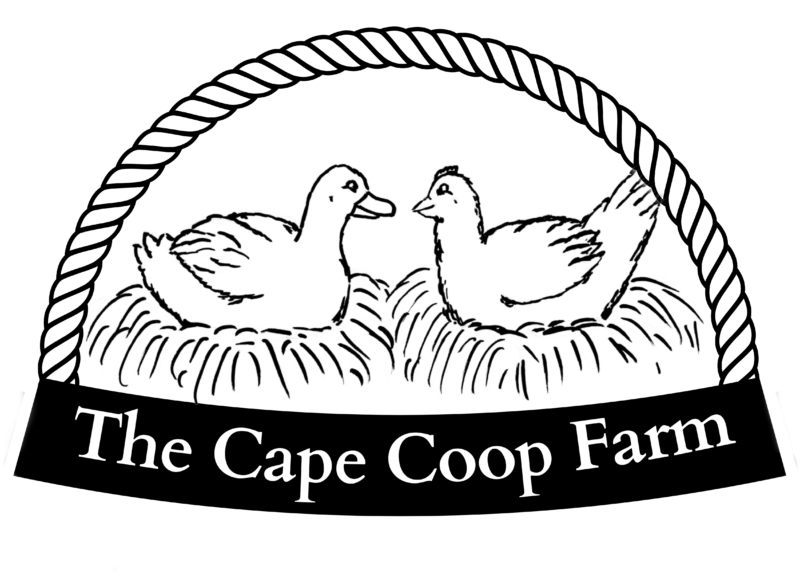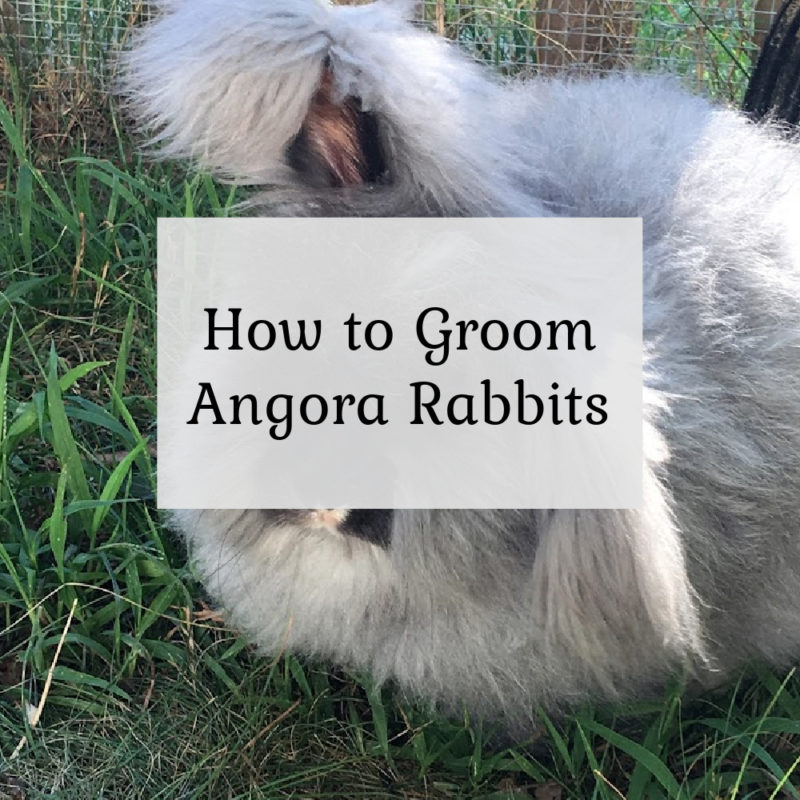---------------------------------------------------------
Is there anything cuter than a fluffy Angora bunny??? Just look at this cute little fluffy face!

All that cute fluff definitely comes at a price. There is a lot of grooming involved to keep Angoras healthy, happy, and producing top-quality wool. Don’t let that deter you from adding one of these sweet fluff balls to your family. If you can set aside about a half hour a week for grooming (and a bit more time during shedding periods) you should be fine!
Grooming and regular handling should start as young as possible for wool breeds. They have a lifetime of handling ahead of them so best to get them used to it early. They won’t be shedding much fur until they are full grown. Grooming when they are young is mostly about bonding with your bunny, and getting them used to regular handling.
Why grooming Angoras is important
Angoras who are not groomed regularly will develop mats. This not only makes their wool unusable, but it is very uncomfortable for them. In extreme cases, matting could prevent them from moving freely, eating, or excreting waste.
Ungroomed Angoras can also develop the deadly conditions of Wool Block or GI Stasis. Click here to read more about this condition. Wool block happens when the rabbit is grooming itself and ingests too much fur. Rabbits can not vomit the fur out (unlike cats with hairballs), so it has to pass through them. Too much fur can accumulate in the bunny gumming up its digestive system and it can very quickly die from this.
A high-fiber diet (lots of hay!) is important for Angoras to keep their digestive system healthy. We like to give our rabbits a papaya vitamin tablet every time we groom them. Papaya has natural enzymes that will help break up the wool, you can find the tablets (good for human digestive systems too!) at health food stores or online.
Shedding Periods
Most Angoras naturally shed their coat every couple of months. How do you know if your rabbit is shedding its coat? It’s pretty hard to miss! When you pet the rabbit, the loose fur will literally fall right out. Looking at the rabbit, you will see loose tendrils of fur falling out like this:

That is when you know it is time to step up the grooming schedule. In non-shedding weeks I usually groom each of my rabbits once a week, taking about 30 minutes per rabbit. During shedding times the grooming takes a bit longer because I am trying to make sure I get all the loose fur, taking about 45-60 minutes per rabbit.
I use combing to remove the excess fur from my rabbits (just like it sounds, combing is just brushing the bunny to get out the loose wool). I usually follow that up with plucking. It isn’t as horrible as it sounds, it is just running your hands through the fur to remove the loose tendrils. You can also shear your rabbit. Click here to read more about combing, plucking, and shearing.
Shearing involves using clippers or scissors to trim the coat off. Shearing is definitely the fastest method. Although it is the fastest, I don’t use it unless the fur is matted because an Angora rabbit’s coat is constantly growing. When you shear the coat you end up taking off not only the old loose fur that is 3-5 inches in length, but you also get the shorter, new fur (about 1-2 inches in length). The longer hairs are preferable if you will be spinning the wool into yarn, the short hairs are considered “second cuts” and often will shed out of the yarn.

Tools for grooming
Before I begin grooming I assemble my tools (scroll to the bottom of the post for handy shopping links!):
- a small slicker brush
- grooming comb
- small, blunt end scissors (mine are dog grooming scissors with blunt ends)
- small nail clippers
- papaya tablets
- baggie, bucket, or box for storing harvested wool
- an old towel
- small bowl of greens for bunny treats!

Holding your rabbit for grooming
You can place your bunny on a study tabletop, or groom them on your lap. Either way, it is very important that you are securely holding your rabbit so it doesn’t fall from the table or twist its body and injure itself. It’s nice to do it outside because there is less mess afterward, but I find it frustrating to have the wind blowing all the hair around. I usually do it inside, and I always end up having to do a good vacuuming afterward!
Place the towel on your table, or on your lap. This will protect your clothes/surface (somewhat!) from the excess fur and will help cushion and cradle the bunny.
I like to groom my bunnies on my lap. It can be a relaxing experience for both me and the bunny. This is Luna, our black English Angora. She is a very chill bun who loves grooming time and cuddles. Luna was just outside hopping around in the play yard so she has lots of “vegetable matter” in her coat – leaves, dirt, shavings – that needs to come out first.
I use my fingers and then the slicker brush to softly brush the tips of the fur to just get out the veggie matter. You can also use a grooming blower to get out the veggie matter & fluff up the coat. This is just a real quick brushing – maybe just a minute or two. Just to get out the debris & fluff the coat.


Combing
For the majority of the brushing, I use a grooming comb. The teeth are close together to help grab the loose fur and help work out any mats. I use short strokes working from the end of the fur down to the skin. Don’t forget to brush their ear furnishings (the fur on their ears), behind their ears, and the fur on their face. Be very careful around their eyes!
Working out mats
If you come upon a mat, try to work it out with the comb. Hold the fur close to the skin, so that as you are brushing the mat it won’t pull at her skin. If the mat is too large or tight to get out with the comb, you will need the blunt-tipped grooming scissors.
Rabbit skin is very thin, you need to be very careful when cutting mats. Before I start cutting the mat out, I will break it down by cutting through the mat perpendicular to the skin. Once it is two or more smaller mats, I can often brush it out. Try not to pull the skin away from the body when you are cutting a mat, that is an easy way to accidentally cut the skin. If possible, try to keep your fingers between the scissors and your rabbit’s skin.
If the large mat is cut into smaller mats and you still can’t comb it out you will need to cut the mat off. To protect the rabbit’s skin, lay the scissors flat against the skin. Don’t pull the skin up, you could accidentally cut her.

Brushing the underside
Now, we have to turn the bunny over and brush her belly, legs, and backside. As the rabbit is lying around and climbing on things the fur on the underside of the rabbit is where mats are most likely to develop. The quality of wool you remove from this area will not be as high quality as the back and sides.
Besides matting, the other issue that can occur with the fur on the underside is felting. This is when the fur is not quite matted but is compressed and coarse – almost the texture of sheep’s wool. Frequent grooming can prevent both matting and felting, but once it’s matted or felted there is not much to be done but to carefully cut the fur off. Felted fur is not great for spinning, but can still be used for various craft projects.

Turning the bunny on her back
To turn the bunny over, gently grasp her ears & back of her head with one hand and cradle her with the other hand to tip her upside down. Place her on your lap. You can secure her ears between your knees, gently, being sure the ears aren’t bent. Most rabbits in this position are quite calm, but be careful as you lean over her as she could use her powerful back legs to kick if she gets spooked, scratching you.
A second position I will use is to cradle the rabbit in my left arm so her head is near my armpit, sort of like you would hold an infant. Then I gently hold one of her back legs with my left hand. You have the rabbit held more securely this way but you won’t have full use of both your hands for grooming. Once you are more comfortable with grooming, I find this to be an easier way to hold them. If a rabbit squirms out of your grip, she could hurt her spine twisting to get out of your grip so it is important to hold her securely.
Gently remove the veggie matter from the fur from her underside and then use the comb to brush her belly & leg fur. Try to do as much grooming as possible while the rabbit is right-side up.
Brushing her back & sides
The best, longest, choice wool comes from the bunny’s back and sides so this is where you will concentrate during wool removal combing. Work in sections until you get the whole body. Use one hand to hold the skin so it doesn’t pull and hurt the bunny as you brush. Use the comb to thoroughly brush out each section. You will have to clear your brush often, so keep your wool collecting bag handy. When you can brush through her fur with hardly any wool coming out you are done.

Other grooming jobs
About once a month, you should trim the rabbit’s nails. You can do this while she is on her back. Carefully push aside the feet fluff and use small nail clippers to trim just the tip of the nail. If the nails are white you can easily see the nail’s blood supply – be sure not to cut that far! If the nails are dark, it can be harder to see, so proceed carefully. A nicked “quick” (the blood supply in the nail) can bleed profusely.
If you do nick the quick, don’t panic. Apply direct pressure with a clean paper towel for a minute or two then dip the nail in styptic powder, such as Kwik-Stop to help the blood clot. In a pinch, cornstarch can be used in place of styptic powder.
While she is still on her back is a great time to check out her teeth. click here for more information on rabbit dental health!
Time for some treats!
Flip the bun back on her feet, pet her, and offer her some greens & a papaya vitamin tablet to reward her for being a good bunny! When you are all done it’s time for the best part! CUDDLE TIME!









reaperdragon4
Friday 13th of December 2024
aren't you worried about stressing your rabbit out restraining them on their back like that? I thought putting them on their back was terrifying for them because it made them think they were gonna be eaten.
Liz
Tuesday 31st of December 2024
If you do it gently with slow movements being sure to craddle them the whole time I have found they do not seem stressed. And I try to brush out their underside as quick as possible to minimize their time on their back
Elizabeth
Tuesday 26th of February 2019
Hi Liz. I just took in an angora bunny that is older. The people that had him did not do anything with him so he doesn't like being held, brushed or barely touch. His fur is very long and and matted underneath and around tail. I can barely see his eyes due to all the fur. Where do I start with him? How do I go about cleaning his fur when I can't hold him? Plz help!
Liz
Wednesday 27th of February 2019
Poor little guy! I think the best way to start with him is to shear his fur down short and start fresh. Then while the fur grows out you can work on earning his trust and hopefully get him used to being handled. During the growing out time, I would recommend doing short brushing sessions of maybe 5 minutes or so a few times per week to get him used to the idea of grooming. Offer him lots of treats during the mini grooming sessions (carrots or apple slices are a great option). Getting underneath him, by his face and by his tail where the mats are now is going to be really difficult to do safely if he doesn't want to be held. You might need some professional help with this first big grooming to get him totally sheared/brushed out. I would suggest contacting your vet for suggestions, some vets will offer grooming services in situations like yours or at the very least should have some suggestions for rabbit savvy groomers. I'm glad he found you! good luck :)
Shari
Sunday 2nd of September 2018
Thanks for helpful information! I brought a beautiful angora bun home from the farm supply store a few weeks ago when I went in to purchase pullets. She had been bought from a local and was VERY matted. I fell in love with her the moment I saw her and am determined to free her from all those horrible mats. I work in short sessions, giving her a break when she gets restless. It is taking a lot longer than I thought it would. I am using small scissors and being careful with her skin. I am not even attempting to save the fleece at this time, but hope to be able to use some for spinning in the future. I am worried that she will go into shedding mode before I get all of the mats removed and it will make the mats worse. About 3/4 of her body was matted, we're down to about 1/4 now - mostly her hind quarters. Any tips for getting through this process faster? My main concern is keeping her calm and not making grooming a time that she wants to resist. She is very sweet. I have not turned her on her back yet, and I really appreciate your instructions for how to do that!
Liz
Sunday 2nd of September 2018
You are definitely going about it the right way! It’s important to get angoras conditioned to grooming and I think if you sat down and groomed her for three hours straight to get all the mats and she was resisting the whole time it would be awful for her. She has likely not been groomed very often. Unfortunately you are probably going to just have to take it slow. My buns like grooming but I’d say even their tolerance is about an hour before they have had enough. If you include in each session maybe 5 minutes of brushing the unmatted fur that should help it stay clean. Did you just trim it all down to the skin? Starting fresh is probably your best bet. Just trim all her fur as short as you are comfortable getting. Then it will all be the same length and can grow back evenly. Tipping them upside down is always the most challenging part! Once they are settled in on their back they go into a calm trance like state for a bit. I cup my left hand around their ears from behind, with my forearm along their spine and just sort of scoop them quickly upside down (like cradling a baby). Once they are upside down, cradle them for a minute or so until the calm down. Now you need your hands free for grooming. I will either lay them on my lap between my legs, lightly holding their ears with my knees, or more like a baby cradle, holding with my left elbow/forearm so my hands are free. Until you are comfortable you could also have someone else hold while you clip. Be careful on her foot bottoms, if she was living in less than ideal conditions on wire floored cages she could have sores on her feet. I like to end all my grooming sessions with some cuddle time and treats so they don’t just associate sitting with me with brushing and cutting. Good luck! I’m glad she is in good hands now!
Red Patrick Desepida
Friday 10th of August 2018
Hello, thanks for this very informative article! I have adopted an adult EA who’s never been groome with a pet blower. From experience, how long would you recommend the first few sessions should be in order to get my bunny used to it? Thanks in advance.
Liz
Friday 10th of August 2018
Congrats on your new little friend! I would see how he reacts to it and take it from there. Try it out for a minute or so and access his mood. If he seems freaked out maybe hold off until the next day, just gradually increasing the time every day for a week or so. He might surprise you though and be ok with the noise. good luck!
Taylor Anderson
Tuesday 7th of August 2018
I like how you mentioned that angora rabbit should start being groomed as soon as possible, as it will help condition them to future grooming. My friend wants to get an angora bunny, but wants to learn more about their grooming and hygiene needs. Are there any other tips she should keep in mind?
Liz
Wednesday 8th of August 2018
Angoras are a lot of fun! I have tons of articles on raising Angoras that I am sure she will find helpful: https://www.thecapecoop.com/angora-rabbits/